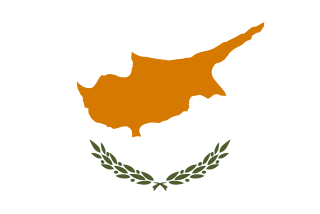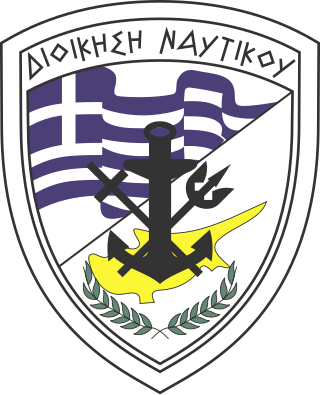| |||||
| Decades: | |||||
|---|---|---|---|---|---|
| See also: | Other events in 1974 · Timeline of Cypriot history | ||||
Events in the year 1974 in Cyprus .
| |||||
| Decades: | |||||
|---|---|---|---|---|---|
| See also: | Other events in 1974 · Timeline of Cypriot history | ||||
Events in the year 1974 in Cyprus .
Ongoing – Cyprus dispute
| | This section is empty. You can help by adding to it. (August 2020) |

Cyprus, officially the Republic of Cyprus, is an island country located in the eastern Mediterranean Sea. It is geographically in Western Asia, but its cultural ties and geopolitics are overwhelmingly Southeastern European. Cyprus is the third-largest and third-most populous island in the Mediterranean. It is located north of Egypt, east of Greece, south of Turkey, and west of Lebanon and Syria. Its capital and largest city is Nicosia. The northeast portion of the island is de facto governed by the self-declared Turkish Republic of Northern Cyprus, a claim not recognised by the international community.

The Republic of Cyprus is a unitary presidential representative republic, whereby the President of Cyprus is both head of state and head of government. Executive power is exercised by the government. Legislative power is vested in both the government and the parliament. The Judiciary is independent of the executive and the legislature.

Famagusta is a city on the east coast of Cyprus. It is located east of Nicosia and possesses the deepest harbour of the island. During the Middle Ages, Famagusta was the island's most important port city and a gateway to trade with the ports of the Levant, from where the Silk Road merchants carried their goods to Western Europe. The old walled city and parts of the modern city are a de jure territory of Republic of Cyprus, currently under the de facto control of Northern Cyprus as the capital of the Gazimağusa District.

The Cyprus problem, also known as the Cyprus dispute, Cyprus issue, Cyprus question or Cyprus conflict, is an ongoing dispute between the leadership of the Greek Cypriot community in the southern portion of Cyprus, and that of the Turkish Cypriot community, situated in the north.

Northern Cyprus, officially the Turkish Republic of Northern Cyprus, is a de facto state that comprises the northeastern portion of the island of Cyprus. Recognised only by Turkey, Northern Cyprus is considered by the international community to be part of the Republic of Cyprus.

Makarios III was a Greek Cypriot politician, archbishop and primate who served as the first president of Cyprus and in which is widely regarded as the Father of the Nation or "Ethnarch". He was also the leader of the autocephalous Church of Cyprus (1950–1977).

Enosis is the movement of various Greek communities that live outside Greece for incorporation of the regions that they inhabit into the Greek state. The idea is related to the Megali Idea, an irredentist concept of a Greek state that dominated Greek politics following the creation of modern Greece in 1830. The Megali Idea called for the annexation of all ethnic Greek lands, parts of which had participated in the Greek War of Independence in the 1820s but were unsuccessful and so remained under foreign rule.
The Annan Plan, also known as the Cyprus reunification plan, was a United Nations proposal to resolve the Cyprus dispute. The different parts of the proposal were based on the argumentation put forward by each party in meetings held under the auspices of the UN. The proposal was to restructure the Republic of Cyprus to become the "United Republic of Cyprus", a federation of two states. It was revised a number of times before it was put to the people of Cyprus in a 2004 referendum, and was supported by 65% of Turkish Cypriots, but only 24% of Greek Cypriots.
Turkish Cypriots or Cypriot Turks are ethnic Turks originating from Cyprus. Following the Ottoman conquest of the island in 1571, about 30,000 Turkish settlers were given land once they arrived in Cyprus. Additionally, many of the island's local Christians converted to Islam during the early years of Ottoman rule. Nonetheless, the influx of mainly Muslim settlers to Cyprus continued intermittently until the end of the Ottoman period. Today, while Northern Cyprus is home to a significant part of the Turkish Cypriot population, the majority of Turkish Cypriots live abroad, forming the Turkish Cypriot diaspora. This diaspora came into existence after the Ottoman Empire transferred the control of the island to the British Empire, as many Turkish Cypriots emigrated primarily to Turkey and the United Kingdom for political and economic reasons.
Greek Cypriots or Cypriot Greeks are the ethnic Greek population of Cyprus, forming the island's largest ethnolinguistic community. According to the 2011 census, 659,115 respondents recorded their ethnicity as Greek, forming almost 99% of the 667,398 Cypriot citizens and over 78% of the 840,407 total residents of the area controlled by the Republic of Cyprus. These figures do not include the 29,321 citizens of Greece residing in Cyprus, ethnic Greeks recorded as citizens of other countries, or the population of the Turkish-occupied Northern Cyprus.
This article covers the civilian casualties and displacements that occurred between 1963 and 1975 – from the outbreak of the intercommunal fighting until the end of displacements following the Turkish invasion of Cyprus.

The Turkish invasion of Cyprus began on 20 July 1974 and progressed in two phases over the following month. Taking place upon a background of intercommunal violence between Greek and Turkish Cypriots, and in response to a Greek junta-sponsored Cypriot coup d'état five days earlier, it led to the Turkish capture and occupation of the northern part of the island.
EOKA-B was a Greek Cypriot paramilitary organisation formed in 1971 by General Georgios Grivas ("Digenis"). It followed an ultra right-wing nationalistic ideology and had the ultimate goal of achieving the enosis (union) of Cyprus with Greece. During its short history, the organisation's chief aim was to block any attempt to enforce upon the Cyprus people what the organisation considered to be an unacceptable settlement to the Cyprus issue. In addition, the organisation drafted various plans to overthrow President Makarios. The organisation continued its activities until it officially declared its dissolution and disbanded on 11 February 1978.

The House of Representatives is the national unicameral legislature of the Republic of Cyprus. Members and three observers representing Armenian, Latin, and Maronite Cypriots are elected by proportional representation every five years. 30% of seats are allocated to Turkish Cypriots, but these have been vacant since 1964. The House of Representatives of Cyprus is the only legislature in Europe within a fully presidential system.
Several distinct periods of Cypriot intercommunal violence involving the two main ethnic communities, Greek Cypriots and Turkish Cypriots, marked mid-20th century Cyprus. These included the Cyprus Emergency of 1955–59 during British rule, the post-independence Cyprus crisis of 1963–64, and the Cyprus crisis of 1967. Hostilities culminated in the 1974 de facto division of the island along the Green Line following the Turkish invasion of Cyprus. The region has been relatively peaceful since then, but the Cyprus dispute has continued, with various attempts to solve it diplomatically having been generally unsuccessful.

Northern Cyprus is recognised only by Turkey, a country which facilitates many of its contacts with the international community. After it was occupied by Turkey, Northern Cyprus' relations with the rest of the world were further complicated by a series of United Nations resolutions which declared its independence legally invalid. A 2004 UN Referendum on settling the Cyprus dispute was accepted by the Turkish Cypriots but rejected by the Greek Cypriots. After that, the European Union declared its intentions to assist in reducing the economic isolation of Northern Cyprus and began giving aid to the territory. However, due to pressure from Greece and the Republic of Cyprus, this aid coming from EU funds cannot be used on Greek Cypriot land and property nor on public bodies. As a result, these funds can be used only on 29 percent of people on the island of Cyprus.

The Cyprus Naval Command is the armed sea wing of the Cyprus National Guard. The Cypriot Navy has the primary mission of defending the maritime borders of the Republic of Cyprus, but is currently unable to access the waters around Northern Cyprus, which have been controlled by the Turkish Navy since the 1974 Turkish invasion of Cyprus. This force does not possess any capital ships or other major warships, but is equipped with patrol boats, landing craft, surface-to-surface missile systems and integrated radar systems, as well as SEALs-type naval underwater demolitions units.

Maratha, Santalaris and Aloda massacre refers to a massacre of Turkish Cypriots by EOKA B; a Greek Cypriot paramilitary group. On 14 August 1974, during the Turkish invasion of Cyprus in the villages of Maratha, Santalaris and Aloda, 89 people from Maratha and Santalaris, and a further 37 people from the village of Aloda were killed. In total, 126 people were killed. The massacre occurred on the same day before the second Turkish invasion, concurring with other massacres.
Greek Cypriot nationalism, also known as Cypriot Hellenism, is a form of ethnic nationalism emphasising the Greekness of the Cypriot nation. It is not the same as Greek nationalism, the main goal of which is the integration of Cyprus into Greece—a process known as enosis. Having abandoned the idea of enosis, Greek Cypriot nationalists now aim to establish a Greek Cypriot-controlled state with close relations to Greece, which they see as their "motherland". Variants of Greek Cypriot nationalism have been espoused across Cyprus' political spectrum by the centre-left Movement for Social Democracy, the centre-right Democratic Party and Democratic Rally, and the right-wing New Horizons, as well as the Church of Cyprus.
Turkish Cypriot nationalism is an ethnic nationalism supporting the independence of the Turkish Republic of Northern Cyprus (TRNC) and mostly desires that the TRNC stay independent from Turkey while opposing the idea of a united Cyprus with the Greek-dominated Republic of Cyprus. The objective of taksim, that is, the partition of the island of Cyprus into Turkish and Greek portions, is widespread among Turkish Cypriot nationalists. Nevertheless, a considerable number of them wish for Turkey to annex Cyprus.
The Greek Cypriots and much of the international community refer to it as an "invasion.